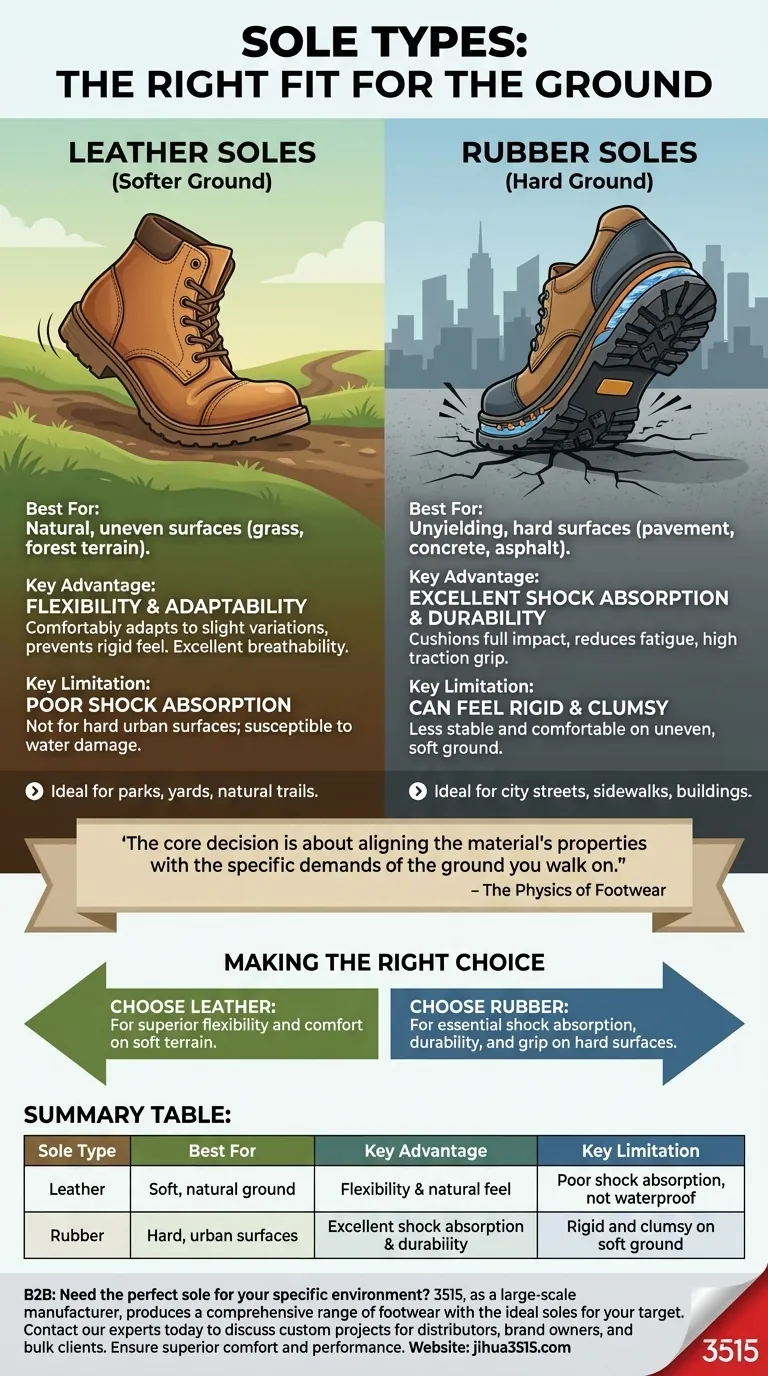For softer ground, leather soles are generally the better choice. Their natural flexibility allows the foot to adapt to uneven surfaces like grass or forest terrain. This adaptability, combined with leather's inherent breathability, provides superior comfort in natural, yielding environments.
The core decision between sole types is not about one being universally "better," but about aligning the material's properties with the specific demands of the ground you walk on. Leather flexes with soft ground, while rubber protects against hard surfaces.

The Physics of Footwear: Why Ground Type Matters
The fundamental job of a shoe sole is to mediate the interaction between your foot and the ground. The properties that make a sole excellent for one surface can become a liability on another.
The Case for Leather on Soft Ground
Leather soles are ideal for natural, softer terrains. Their construction allows them to bend and conform to the slight variations in surfaces like grass, dirt paths, or a forest floor.
This flexibility prevents the feeling of walking on rigid "planks," offering a more natural and comfortable stride. Leather's breathability also helps manage moisture, which is a key comfort factor during extended outdoor wear.
The Case for Rubber on Hard Ground
Rubber soles are engineered for unyielding, hard surfaces. Pavement, concrete, and asphalt offer no shock absorption, forcing your feet and joints to bear the full impact of every step.
Rubber's primary advantage here is its excellent shock absorption, which cushions this impact and reduces fatigue. Its durability and high-traction grip are also critical for providing stable, long-lasting performance on abrasive urban terrain.
Understanding the Trade-offs
Choosing a sole material always involves a compromise. There is no single sole that excels in all conditions.
Leather Sole Limitations
The very properties that make leather great for soft ground make it unsuitable for hard, wet urban environments. It offers minimal shock absorption on concrete and can wear down quickly on abrasive pavement. Furthermore, leather is susceptible to water damage, losing its structure and integrity when saturated.
Rubber Sole Limitations
On the other hand, a thick, rigid rubber sole can feel clumsy and restrictive on soft, uneven ground. It lacks the flexibility to conform to the terrain, potentially leading to a less stable and less comfortable experience. While great for durability, this rigidity works against the natural movement of your foot on soft surfaces.
Making the Right Choice for Your Environment
To select the best sole, match the material's primary strengths to the ground you will spend the most time on.
- If your primary environment is parks, yards, or natural trails: Choose leather soles for their superior flexibility and comfort on soft, uneven terrain.
- If your primary environment is city streets, sidewalks, and buildings: Choose rubber soles for their essential shock absorption, durability, and grip on hard, unforgiving surfaces.
Ultimately, aligning your footwear with its intended environment is the key to maximizing both comfort and longevity.
Summary Table:
| Sole Type | Best For | Key Advantage | Key Limitation |
|---|---|---|---|
| Leather | Soft, natural ground (grass, dirt trails) | Flexibility & natural feel on uneven terrain | Poor shock absorption on hard surfaces; not waterproof |
| Rubber | Hard, urban surfaces (pavement, concrete) | Excellent shock absorption & durability | Can feel rigid and clumsy on soft, uneven ground |
Need the perfect sole for your specific environment?
As a large-scale manufacturer, 3515 produces a comprehensive range of footwear for distributors, brand owners, and bulk clients. Our production capabilities encompass all types of shoes and boots, allowing us to create the ideal footwear with the right sole for your target market's needs—whether it's flexible leather for outdoor comfort or durable rubber for urban durability.
Contact our experts today to discuss your custom footwear project and ensure superior comfort and performance for your customers.
Visual Guide

Related Products
- Wholesale Leather Ankle Boots with Lug Soles for Custom Brand Manufacturing
- Wholesale Leather Work Boots with Customizable Wedge Sole for Brands
- Wholesale Comfort Leather Business Shoes with Dial Lacing System
- Durable Leather Work Boots Wholesale Manufacturer & Custom Factory
- Safety Footwear Wholesale Manufacturer for Custom OEM/ODM Production
People Also Ask
- What are the benefits of classic black lace moc toe shoes? Achieve Polished, Versatile Style
- Is heavy, stiff footwear necessary for good ankle support? The Truth About Boot Design & Injury Prevention
- What are the key considerations when choosing dress shoes for formal occasions? A Guide to Style, Color & Quality
- Why are high quality leather linings important for boots? Enhance Comfort, Durability & Foot Health
- How can one balance a casual outfit when wearing dress shoes? Achieve a Polished Smart Casual Look



















